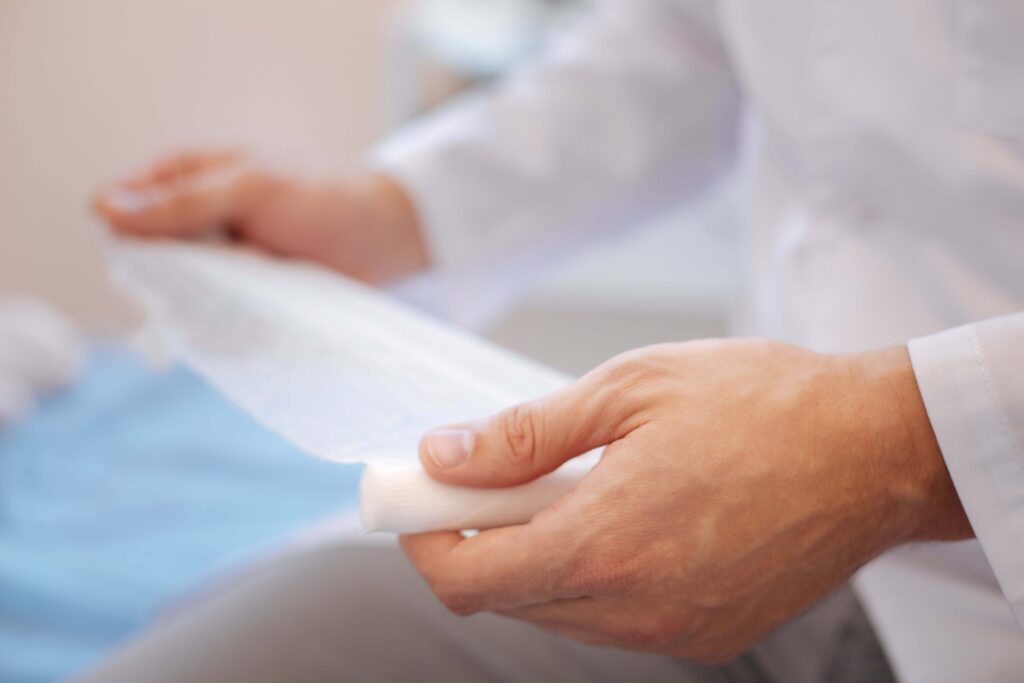In wound care, breakthroughs in materials science, bioengineering, and digital monitoring are redefining how wounds are treated and healed. At West Coast Wound Care, we do everything we can to provide the most advanced care possible. As such, that means being on top of what’s new, in this year or any other. This can include treatment, wound dressings, and so much more.

Smart Dressings: From Passive to Responsive
Traditional dressings act as passive barriers: they protect the wound, absorb exudate, and maintain moisture. New advanced “Smart Dressings” are designed to go several steps further. These are dressings embedded with sensors, microelectronics, or responsive materials that monitor or even intervene in the wound environment in real time.
According to this article “A review on smart dressings with advanced features,” these advancements “have enabled real-time monitoring, targeted therapy, and controlled release of medications,” among other benefits.
What makes these “Smart dressings” “smart,” in part, is that they can pick up on so much. There have been reports that some of these can pick up pH changes (a potential sign of early infection), as well as temperature shifts, oxygenation, and more.
Some dressings can drain excess fluid on their own, while others can trigger controlled release of approved drugs/antimicrobial agents. As these “Smart dressings” can be calibrated to being sensitive to changes in a patient’s condition, they can help to provide better, more targeted, and more timely care.
At West Coast Wound Care, when a patient’s wound warrants it, we evaluate whether a smart dressing is advantageous in their case. Our wound care specialist team is trained to select sensor-enabled dressings (where available) and integrate the data into our treatment protocols.
Skin Substitutes and Bioengineered Therapies
“Bioengineered skin substitutes” may sound like something from science fiction. However, it’s a form of wound dressings that can be used for more effective healing. When a wound fails to reduce in size over several weeks under standard care, guidelines increasingly recommend moving to skin substitutes as an advanced therapy.
When a wound resists conventional therapy or becomes chronic, bioengineered skin substitutes can play a transformative role. These are scaffolds, cellular or acellular constructs, or living tissue grafts that bridge the gap between injured tissue and full repair. This article, “Skin substitutes: as treatment for chronic wounds: current and future directions” goes into greater detail.
Essentially, these versions are frameworks made of collagen, extracellular matrix components, or synthetic polymers. They don’t carry live cells, but they provide structure for the body’s cells to migrate, proliferate, and remodel tissue. Those are many big words which all mean that they can provide for better healing outcomes.
Those are far from all that’s available. Some substitutes include living cells (keratinocytes, fibroblasts) or multiple layers that approximate skin architecture (dermis + epidermis).
One of their key advantages is that they can be applied without creating a donor site on the patient (i.e. no skin harvesting) and accelerate wound closure.
At West Coast Wound Care, we evaluate chronic wounds in our clinics or during mobile visits for suitability for these therapies. Our wound care specialists determine which treatments are appropriate.
Other Cutting-Edge Treatments in 2025
Beyond smart dressings and skin substitutes, additional innovations are emerging to push wound care forward. For example, some dressings are engineered to respond to changes in the wound microenvironment. For example, a hydrogel that responds to temperature or pH to release antimicrobials on demand, or a photodynamic dressing that generates reactive oxygen species when exposed to light to kill bacteria is currently being experimented with.
One new polymer derivative builds UV-cured and photodynamic antimicrobial capability into a fiber structure. Under light exposure, it triggers microbial kill while remaining biocompatible.
Not every new treatment will be right for each patient. However, we can tell you that, here at West Coast Wound Care, our pros always use the right treatments for our patients.
Wound Tracking for Better Wound Care
There have been plenty of advancements in wound tracking in addition to wound dressings. Still another frontier is digital wound tracking. Seemingly every day, tech becomes available to enable patients to take better, more detailed photos of their wounds.
Some can even be segmented with AI models to report symptoms and more.
How We Use Innovation in Our Clinics and Mobile Service
At West Coast Wound Care, we study and learn all there is to know about these new advancements. This is a significant portion of how we deliver care.
Our clinical locations are stocked with advanced materials so when a patient presents with a stubborn or complex wound, our wound care specialist team can evaluate and provide appropriate care immediately.
In our mobile wound care service, we bring clinical-grade solutions to your door. That means if a patient’s wound requires it, we can apply and monitor those technologies just as effectively in the field as in the clinic.
We always assess each wound’s particular needs—depth, perfusion, infection risk, exudate levels, and so much more—all to select the dressing or substitute that gives the wound the best environment for recovery. We don’t simply apply the “latest gadget”; we choose based on sound criteria and integrate monitoring into follow-up care.
Better Wound Dressings for Better Wound Healing
We believe that the best healing comes when cutting-edge science meets personalized care. The innovations emerging in wound dressing technology are reshaping how we approach wound recovery. For patients dealing with acute or chronic wounds, these tools offer new hope and faster, safer healing trajectories.
Whether in our clinics or via mobile wound care visits, we’re ready to evaluate your wound, recommend the right advanced technologies, and guide you toward optimal recovery. If you or a loved one are managing a wound that seems stalled, showing signs of infection, or not progressing as expected, please reach out to us. Schedule a free appointment today.
